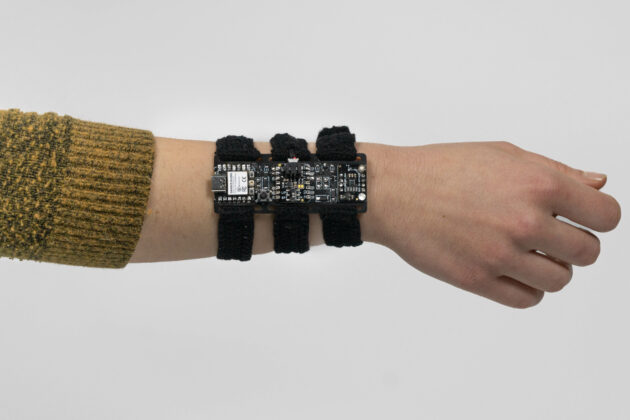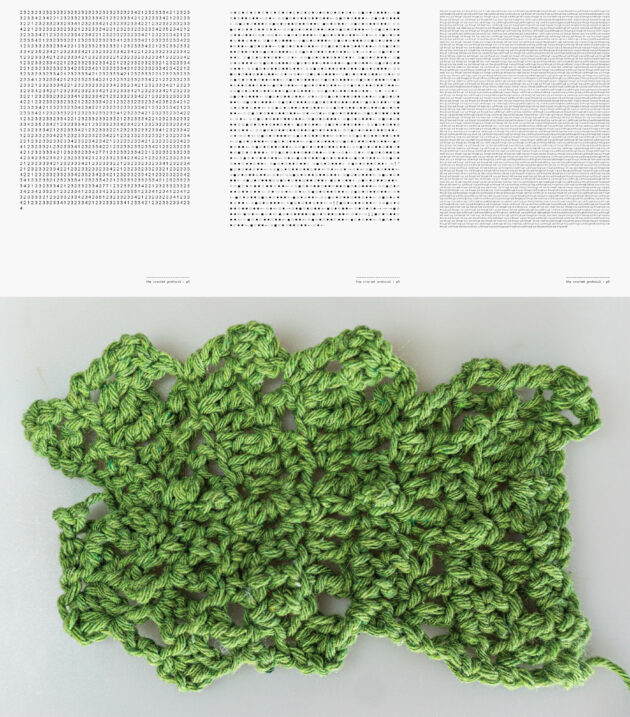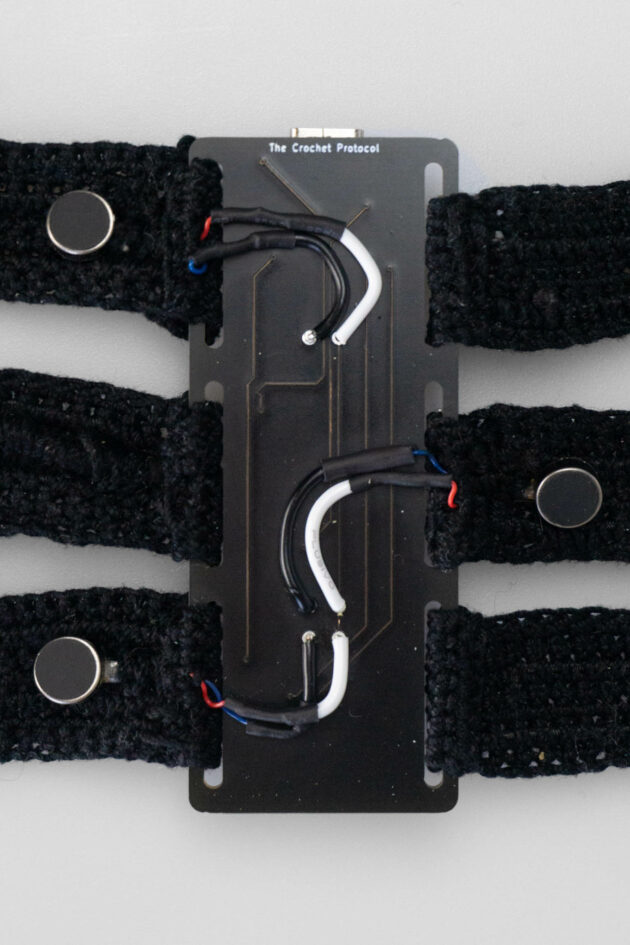The Crochet Protocol

What would it be like, when a device is telling the wearer what to do?
The Crochet Protocol consists of a wearable bracelet with an ESP32 and three vibration motors which are used to present generated instructions.
The wearer is told through vibration signals the next instruction and it is their job to interpret these signals and follow the loops and decisions of the device.
Despite the not quite obvious connection, crocheting seems to embed similar features as coding. This project is an exploration of the interaction between crocheting, the code, the wearer and the controls through the machines. What does it take for the wearer to learn and understand the instructions given through the wearable device? What are the power dynamics? And what is the sensory feeling and the implications of the bracelet?
The protocol is previously agreed on. The creative choice regarding crocheting is taken away from the wearer and they are simply reduced to completing the work imagined and timed by the device.
The Crochet Protocol is an attempt to combine two apparently very different personal interests of the artist: Crocheting + Code
Crochet

The motor vibrations can only be felt by the wearer, who has to follow a new protocol and accustomed themselves to the new sensory feeling.
Crocheting is socially regarded as a handcraft mostly associated with women. The technology constructs power structures only felt by the individual and unbeknown to others around.
But also the different aspects of crocheting like repeats, loops and stitches, crocheting offers similar characteristics as code.
Within the crocheting communities, it is widely agreed on that crocheting cannot be easily replicated by a machine as “there is no similar mechanism for making the transverse chains that are another definitive attribute of hand crochet. A machine that can produce true crocheted fabric therefore remains to be devised.” ([see Cary Karp](https://loopholes.blog/2021/02/warp-crochet/?subscribe=success#blog_subscription-3) ). Therefore, crocheting lends itself perfectly to the scenario of the machine in need of human labor.
Protocol
The instructions for crocheting are created by the device itself. In order to break down the steps and stitches within crocheting, a protocol consisting of seven different steps has been developed. These steps are interpreted in various ways within the system. On a higher level, these signals represent the common steps that underlie every stitch: insert, loop, pull through, left, right, front, back. The steps are visually represented through words, numbers and symbols. Looking at these steps as numbers, the device then again transforms them to the vibration signals using the three motors.

Based on the protocol, instructions that follow the basic rules of creating 2D crocheted items are generated. The created pieces are not intended to be useful. The instructions are in some part arbitrary and force the wearer to pay close attention as the next step might not be, what an experienced crocheter would expect.
Device

The bracelet consists of a custom printed circuit board featuring an ESP32 with WiFi, an accelerometer, a power management system, three coin vibration motors, switches and a small compact Li-Po battery. To secure the motors in place and guarantee close contact to the arm of the wearer, the bracelet is secured with three crocheted bands that allow individual adjustment for each of the motors for various arm sizes. Additionally, the battery is discreetly woven into one of the bands.

The bracelet is mostly designed for people with crocheting experience, but others can attempt to follow the instructions as well. Upon first wearing the bracelet, a settling-in period is needed to fully become in tune and recognize the differences and changes of the vibration motors. At first, the signals seem to be very hard to distinguish but through longer usage, the body becomes adapted to the bracelet and gets a new sense for the vibrations. While following the device’s instructions, the wearer experiences both predictable patterns as well as unusual happenings, that require them to make their own decisions.
The haptic instructions allow no foresight and also place the instructions to a specific moment in time with no back or forth. As crocheting is a tactile craft as well, the instructions are placed in close proximity, situated right next to the actual crocheting and becoming part of the tactile event itself.

More
A more extensive text about this project, can be found on the
[Algorithmic Pattern Salon 2023 publication]

